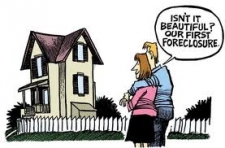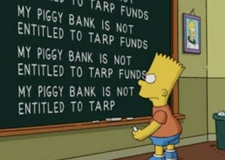Sometimes people thinking outside the box come up with great solutions to difficult problems; however, sometimes people believe they are innovative when they are merely clueless and inept.


Irvine Home Address … 7 PEARLEAF Irvine, CA 92618
Resale Home Price …… $599,900

As I sift and drift through bullshit,
That plagues from day to day,
Would you ever really notice I've gone away?
I'm over the wall,
Over the hill,
Over at your place,
I'm over the safeties,
Over the phone calls,
Over the rage,
What a mistake.
Nickelback — Mistake
Not long ago, I wrote about Government Bureaucrat Recommends Against 30-Year Fixed-Rate Mortgages and Another Ignorant and Misguided Attack on the 30-Year Fixed-Rate Mortgage. Both of those pieces were emtional appeals with poorly reasoned positions. It was apparent from reading them that the authors had an agenda supported by banking interests that would rather see everyone borrow with adjustable rate mortgages at the bottom of the interest rate cycle.
Today's featured article comes from the New York Time's “expert” on mortgages and related issues. Unfortunately, just as the previous two writers did, she wrote an emotional appeal with little substance supporting a dubious agenda. Shame on the New York Times for calling this news.
Housing Doesn’t Need a Crash. It Needs Bold Ideas.
By GRETCHEN MORGENSON
Published: September 11, 2010
WE all know that most of us don’t tackle problems until they’ve morphed into full-blown crises. Think of all those intersections that get stop signs only after a bunch of accidents have occurred.
Better yet, think about the housing market.
Only now, after it has become all too clear that the government’s feeble efforts to “help” troubled homeowners have failed, are people considering more substantive approaches to tackling the mortgage and real estate mess. Unfortunately, it’s taken the ugly specter of a free fall or deep freeze in many real estate markets to get people talking about bolder alternatives.
Wait a moment. She has dressed up her non-problem with plenty of emotional language, but why is this a problem that needs government intervention? Who says this is a “crisis?” Whatever “mess” we have is largely caused by all the government intervention. The “ugly specter of a free fall or deep freeze” is the natural cleansing process of a financial market. Too bad if that is politically unpopular.
One reason the Treasury’s housing programs have caused so much frustration among borrowers — and yielded so few results — is that they seemed intended to safeguard the financial viability of big banks and big lenders at homeowners’ expense.
It isn't that these programs “seemed” intended to benefit banks as the expense of homeowners, the frustration among borrowers is because these programs are intended to benefit banks at the expense of borrowers. The perception of borrowers is accurate, and they should be more than just frustrated, borrowers should be pissed off.

For example, the government — in order, it believed, to protect the financial system from crumbling — has never forced banks to put a realistic valuation on some of the sketchy mortgage loans they still have on their books (like the $400 billion in second mortgages they hold).
All those loans have been accounted for at artificially lofty levels, and have thereby provided bogus padding on balance sheets of banks that own them. Banks’ refusal to write down these loans has made it harder for average borrowers to reduce their mortgage obligations, leaving them in financial distress or limbo and dinging their ability to be the reliable consumers everyone wants them to be.
There is much nonsense in that last sentence. First, she is making a nonexistent connection between the banks refusal to accept write downs and the problems borrowers have with excessive debt. In some fantasy world of borrowers where banks forgive debt, this connection may exist, but in the real world, banks don't reduce borrower's mortgage obligations, borrowers do that by paying off their loans.
Banks refusal to accept write downs has resulted in widespread banking paralysis and lots of squatting, but that is a banking problem not a borrower problem. Borrowers don't really care because they have reduced their indebtedness by simply refusing to pay back the debt. Nothing the banks are doing has any connection to this borrower behavior except perhaps that the banks refusal to foreclose prompted more borrowers to default and eliminate their debt.
While it is true that over-indebted borrowers don't spend and stimulate the economy, widespread debt forgiveness outside of foreclosure is not the solution. What incentive would borrowers have to borrow prudently in the future? She has set up her argument to promote a solution that involves decreasing borrower distress without acknowledging the moral hazard any such effort creates. Borrowers who cannot afford their debt need to go through foreclosure and probably bankruptcy otherwise they will repeat the mistake.
Various proposals are being batted around to address the mortgage morass; one is to do nothing and let real estate markets crash. That way, the argument goes, buyers would snap up bargains and housing prices would stabilize.
Yes, that is the only viable solution to the problem, yet it is the solution everyone works against. Her argument below isn't that letting market prices fall would bring stabilization, her argument is that it will take a while because so many are frozen out of the market.
Yet little about this trillion-dollar problem is so simple. While letting things crash may seem a good idea, there are serious potential complications. Here’s just one: Many lenders and some government agencies bar borrowers who sold their homes for less than the outstanding loan balance — known as a “short sale” — from receiving a new mortgage within a certain period, sometimes a few years.
For example, delinquent borrowers who conducted a short sale are ineligible for a new mortgage insured by the Federal Housing Administration for three years; Fannie Mae blocks such borrowers for at least two years. Private lenders have similar guidelines.
Such rules made sense in normal times, but their current effect is to keep many people out of the market for years. And as home prices have plunged, leaving legions of borrowers underwater on loans, short sales have exploded. CoreLogic, an analytic research firm, estimates that 400,000 short sales are taking place each year.
More can be expected: 68 percent of properties in Nevada are worth less than the outstanding mortgage, CoreLogic said, while half in Arizona and 46 percent in Florida are underwater.
“There is this perception that maybe we should let the market crash and then prices will level off and people will come out and buy,” said Pam Marron, a senior mortgage adviser at the Waterstone Mortgage Corporation near Tampa, Fla. “But where are the buyers going to come from? So many borrowers are underwater and they’re stuck; they can’t buy another home.”
She has devoted a significant block of text to setting up the mortgage waiting period as a bogeyman. The logical conclusion from her problem definition is that we should shorten or eliminate the waiting period to get a new loan after a foreclosure. I addressed this bad idea in Fannie Mae Encourages Strategic Default by Reducing Punishment Time for New Loan. To solve the problem she describes would create an avalanche of accelerated default as every underwater loan owner in America would default and buy a different home at a much lower price.
Despite devoting so much space to making this point, it does nothing to support the argument she makes later. It reads more like a feeble attempt to justify some form of market intervention when none is required.
There is no doubt that real estate and mortgage markets remain deeply dysfunctional in many places. Given that the mess was caused by years of poisonous lending, regulatory inaction and outright fraud — and yes, irresponsible borrowing — this is no surprise. Throw in the complexity of working out loans in mortgage pools whose ownership may be unclear, and the problem seems intractable.
The moral hazard associated with helping troubled borrowers while penalizing responsible ones who didn’t take on outsize risks adds to the difficulties.
All the difficulties she outlines above are very real, but the problems are not intractable. All these problems are resolved by the foreclosure process. The debts are wiped clean, the imprudent borrowers are punished, and moral hazards are avoided — that is why we have foreclosure as part of the system. Just because people may not like the way the system works doesn't mean there is a better system. If the government would stop messing around and either allow or force these foreclosures and write downs to occur, we could get back on solid economic footing and move on.
STILL, there are real, broad economic gains to be had by helping people who are paying their mortgages to remain in their homes.
What the hell is she talking about? People who are paying their mortgages are remaining in their homes. I haven't heard of any borrowers who are current on their payments going into foreclosure, have you?
Figuring out how to reduce their payments can reward responsible borrowers while slowing the vicious spiral of foreclosures, falling home prices and more foreclosures. And it just might help restore people’s confidence in the economy and get them buying again.
OMG! That is the most ridiculous thing I have read in quite a while. How does rewarding responsible borrowers slow the “vicious spiral of foreclosures?” (Notice the emotional language she chose.) Responsible borrowers are not causing foreclosures. Second, what does any of this have to do with consumer confidence?
What she is proposing is that we give these people money in the form of lower payments so they will go spend it. Do we really want to stimulate the economy by giving money to underwater loan owners? I don't. Not even a penny.
With that in mind, let’s recall an idea described in this space on Nov. 16, 2008. As conceived by two Wall Street veterans, Thomas H. Patrick, a co-founder of New Vernon Capital, and Macauley Taylor, principal at Verum Capital, the plan calls for refinancing all the nonprime, performing loans held in privately issued mortgage pools (except for Fannie’s and Freddie’s) at a lower rate.
The mass refinancing could have helped borrowers, while retiring mortgage securities at par and thus helping pension funds, banks and other investors in those pools recover paper losses created when prices plummeted. Fannie Mae and Freddie Mac could have financed the deal with debt.
Now we come to the crux of her idea: take taxpayer money to buy underwater privately-held mortgages at full par value and make investors whole. I can't think of a worse way to waste taxpayer money.
For example, lets say a MBS pool has a $500,000 mortgage on a house that is now worth $400,000. That loan owner cannot refinance, and only the feeble hope of a recovery that is not forthcoming keeps him from accelerating his default. She is proposing that the US Taxpayer pay $500,000 for this loan, write down the interest rate, and pray that the poor schmuck we are “helping” doesn't realize we extended his debt servitude. When borrowers realize they are still hopelessly underwater, they will accelerate their default anyway, and the taxpayer ends up covering the loss — a loss that would otherwise be absorbed by a private investor. Does she really think this will solve the problem borrowers have with benefiting banks at borrower expense?
This is a blatant attempt to shift losses from the private sector to the US taxpayer. This is her “bold idea?”.jpg)
In the fall of 2008, when Mr. Patrick and Mr. Taylor tried to get traction with their proposal, roughly $1.5 trillion in mortgages sat in these pools. Of that, $1.1 trillion was still performing.
Instead of refinancing those mortgages, however, the Washington powers-that-be hurled $750 billion of taxpayer money into the Troubled Asset Relief Program, which bailed out banks instead.
Do you think investors in MBS pools put her up to this article? After all, they didn't get any of the TARP money because it all went to banks. Since we are bailing out banks from their bad investments, why shouldn't we bail out ordinary stupid investors?
Though one goal was to get banks lending again, it hasn’t happened.
Now, almost two years later, $1.065 trillion of nonprime loans is sloshing around in private mortgage pools, according to CoreLogic’s securities database. While CoreLogic doesn’t report the dollar amount of loans that are performing, it said that as of last June, two-thirds of the 1.6 million loans in those pools were 60 days or more delinquent.
Wow! Two-thirds of a trillion dollars in nonprime loans are delinquent. No wonder MBS pool investors are using Gretchen to pitch their bailout.
That means one-third of the borrowers in these pools are paying their mortgages. But it is likely that many of these people owe more on their loans than their homes are worth and would benefit greatly from an interest-rate cut.
Despite cloaking it as a benefit to borrowers, she is proposing that we save the full market value of the last third of the MBS pools through a government bailout. Who do you think this really benefits?
If Fannie and Freddie bought these loans out of the pools at par and reduced their interest rates, additional foreclosures might be avoided. The only downside to the government would be if some loans it purchased went bad.
The only downside? How many billions in taxpayer dollars will it take to cover this “only downside?” If it isn't that much, perhaps the MBS holders should take the loss. if it is a lot, then the MBS holders should certainly take the loss. What possible justification is there for this kind of MBS bailout?
The benefits of the plan could easily outweigh the risks. Institutions holding these loans would be fully repaid, a lot of borrowers would be helped and additional foreclosures that are so damaging to neighborhoods might be averted.
Let's take these “benefits” one at a time:
- “Institutions holding these loans would be fully repaid.” As a taxpayer, why the hell do I care about institutional losses? Why should I be paying money to cover the losses of professional investors? The idea that even one penny of my tax dollars would go toward this infuriates me.
- “a lot of borrowers would be helped.” How exactly does this happen? The borrower is still underwater. Making his payment affordable doesn't help him, it just makes his debt servitude manageable. What would really help is for him to go through foreclosure and eliminate the debt.
- “additional foreclosures that are so damaging to neighborhoods might be averted.“ This bullshit gets used every time someone wants to promote their latest bailout. Foreclosures have not caused riots, nor have they caused neighborhoods to deteriorate. Foreclosures have lowered property values and made many existing owners unhappy, but their neighborhoods are not “damaged” despite repeated claims that they are.
Every point she makes in summation to support her argument is nonsense.
“Every program that the government has announced was focused on bad credits, but they were trying to fix a hole that is too big,” Mr. Patrick said. “The idea is to try to preserve the decent risks and not let them go bad.”
At the very least, this is a sophisticated and realistic idea that’s still worth considering.
Give me a break. I give her credit; she does know how to polish a turd. This idea is neither sophisticated nor realistic; it is simplistic and stupid. The only beneficiaries are holders of MBS pools of toxic mortgages who will get to offload their crap on the US taxpayer. People considering this idea are not sophisticated; in fact, they are sheeple.
Seriously, do you think Ms. Morgenson is getting paid off, or is she just thick?
HELOCs are bad for your financial health
What lesson do you think Californians have learned about HELOCs?
- HELOCs are bad and using them often leads to foreclosure.
- HELOCs are great because they provide free money you don't have to pay back.
From what I have observed about human nature, some will learn lesson 1 (the right answer), but with the plethora of bailouts offered up to loan owners, most will learn lesson number 2, and our housing market is now doomed to be ruled by Ponzis.
- Today's featured property was purchased on 11/9/2004 for $615,000. The owners used a $491.920 first mortgage and a 123,080 down payment.
- On 8/17/2005 they refinanced the first mortgage for the same amount.
- On 3/13/2007 they obtained a $168,800 HELOC from Washington Mutual.
- On 3/19/2007 they obtained a $250,000 HELOC from Bank of America.
-
Does anyone smell mortgage fraud here? This couple processed HELOC applications at two banks simultaneously, and the applications were approved within days of one another. You have to assume they took out all the money. Why else would you get two HELOCs from two different banks at the same time?

- Total property debt was $909,920.
- Total mortgage equity withdrawal was $418,000 assuming they withdrew all the money from both HELOCs.
- They didn't get to squat long. I suspect the banks expedited the foreclosure process because of the mortgage fraud.
Foreclosure Record
Recording Date: 06/24/2010
Document Type: Notice of Sale
Foreclosure Record
Recording Date: 03/23/2010
Document Type: Notice of Default
The property was purchased at auction on 8/11/2010.


Irvine Home Address … 7 PEARLEAF Irvine, CA 92618 ![]()
Resale Home Price … $599,900
Home Purchase Price … $615,000
Home Purchase Date …. 11/9/2004
Net Gain (Loss) ………. $(51,094)
Percent Change ………. -8.3%
Annual Appreciation … -0.4%
Cost of Ownership
————————————————-
$599,900 ………. Asking Price
$119,980 ………. 20% Down Conventional
4.36% …………… Mortgage Interest Rate
$479,920 ………. 30-Year Mortgage
$115,325 ………. Income Requirement
$2,392 ………. Monthly Mortgage Payment
$520 ………. Property Tax
$150 ………. Special Taxes and Levies (Mello Roos)
$50 ………. Homeowners Insurance
$75 ………. Homeowners Association Fees
============================================.jpg)
$3,187 ………. Monthly Cash Outlays
-$396 ………. Tax Savings (% of Interest and Property Tax)
-$648 ………. Equity Hidden in Payment
$191 ………. Lost Income to Down Payment (net of taxes)
$75 ………. Maintenance and Replacement Reserves
============================================
$2,408 ………. Monthly Cost of Ownership
Cash Acquisition Demands
——————————————————————————
$5,999 ………. Furnishing and Move In @1%
$5,999 ………. Closing Costs @1%
$4,799 ………… Interest Points @1% of Loan
$119,980 ………. Down Payment
============================================
$136,777 ………. Total Cash Costs
$36,900 ………… Emergency Cash Reserves
============================================
$173,677 ………. Total Savings Needed
Property Details for 7 PEARLEAF Irvine, CA 92618
——————————————————————————
Beds: 3
Baths: 2 full 1 part baths
Home size: 1,750 sq ft
($357 / sq ft)
Lot Size: n/a
Year Built: 2000
Days on Market: 30
Listing Updated: 40415
MLS Number: S628875
Property Type: Condominium, Residential
Community: Oak Creek
Tract: Acac
——————————————————————————
NEWER DETACHED SINGLE FAMILY HOME IN BEAUTIFUL NEIGHBORHOOD WITH POOL AND SPA. GREAT FLOORPLAN: GARAGE AND GUEST SUITE AT GROUND LEVEL. LIVING ROOM WITH FIREPLACE, OPEN TO DINING ROOM AND KITCHEN – WITH WHITE CABINETS AND BREAKFAST BAR – ON SECOND LEVEL, ALONG WITH INSIDE LAUNDRY ROOM WITH CABINETS AND SECOND BEDROOM AND BATHROOM; THE TOP LEVEL IS A MASTER SUITE WITH ADJACENT SITTING ROOM OR OFFICE AND A LARGE MASTER BATHROOM WITH SEPARATE TUB AND SHOWER AND WALK-IN CLOSET. NEW CARPET; TILE FLOORING IN DINING ROOM, KITCHEN, LAUNDRY ROOM AND BATHROOMS; SMOOTH CEILINGS; RECESSED LIGHTING. LARGE PATIO; READY TO MOVE IN.













 I hope you have enjoyed this week, and thank you for reading the Irvine Housing Blog: astutely observing the Irvine home market and combating California Kool-Aid since 2006.
I hope you have enjoyed this week, and thank you for reading the Irvine Housing Blog: astutely observing the Irvine home market and combating California Kool-Aid since 2006.










.jpg)










